Like most New York City parks that have opened with fanfare in recent years, Domino Park, on the East River in Williamsburg, Brooklyn, isn't city-run, but privately funded and maintained.
The first completed stage of a larger redevelopment of the old Domino Sugar Refinery, six-acre Domino Park is a vast improvement over the desolate stretch of waterfront that had defined this edge of the neighborhood since Domino closed the plant in 2004. And with its creative reuse of relics of the industrial past, the park is spectacular in a splashy sort of way.
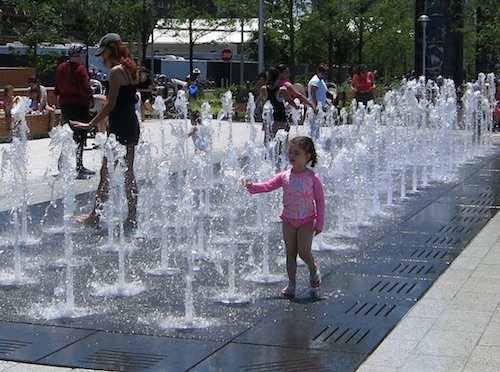
It's also weirdly theme-park-ish, an effect that's especially notable if you cross into it from dusty old Grand Ferry Park which borders its northern edge. Grand Ferry Park also has an industrial relic – a hundred-year-old smokestack from a Pfizer molasses plant. You could say Domino Park took that idea and ran with it to the extreme – inspired also, no doubt, by the High Line, New York City's most famous conversion of industrial infrastructure to park facilities and another instance of private development stepping in where city funds don't dare to tread. But the contrast between the big, shiny new park and its little, scuffed-up old neighbor is extreme.
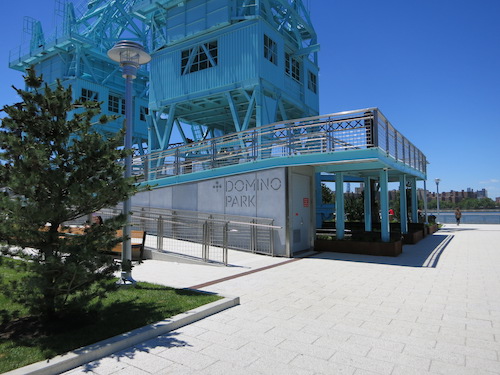
The photo above shows the northern entrance to Domino Park and to the elevated catwalk called Artifact Walk, which stretches for several blocks.
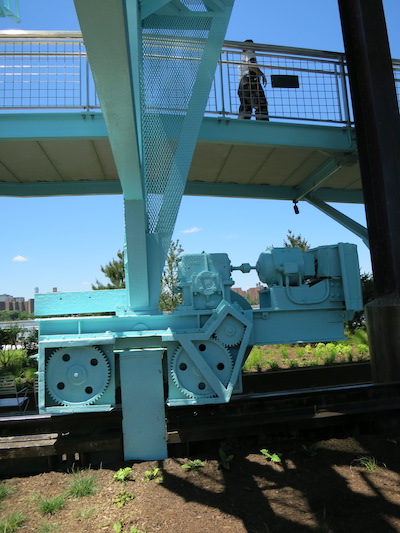
The walk incorporates two large cranes from refinery days, the whole thing painted in what Curbed describes as "the park's signature turquoise," a cheery, summery hue that softens all the hard, heavy metal into a gentle, Disneyish playpen.
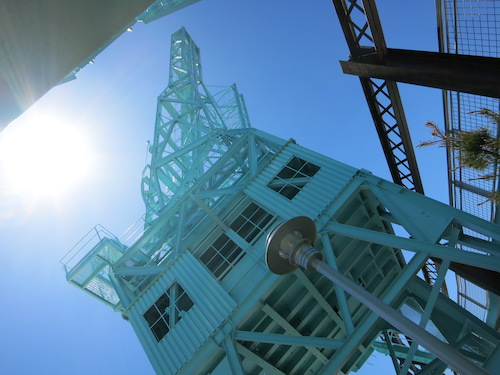
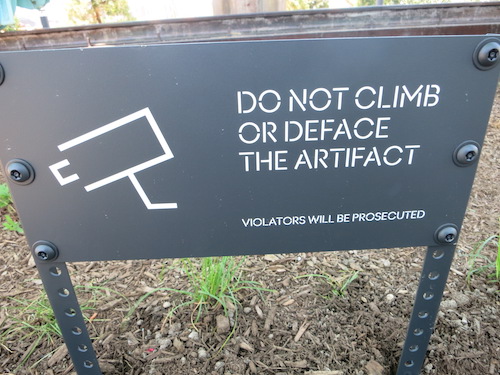
The elevated walkway offers a panoramic view of the park, the river, and the Williamsburg Bridge, which was the world's longest suspension bridge when it opened in 1903.
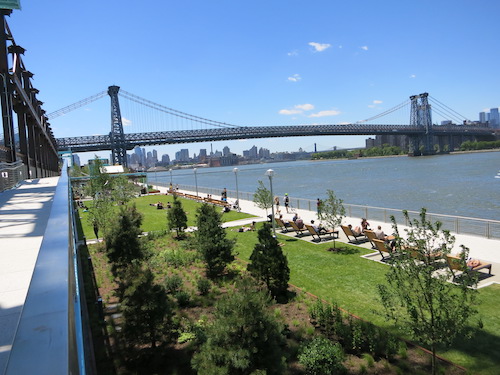
The park platform itself, with its "sustainable foliage and trees, a mix of natives and exotics" according to Architectural Digest, has been built "above the 100-year flood elevation and set back 100 feet from the water's edge." Of course, we know terms like "100-year flood" have little meaning now, well into the Anthropocene.
There are a couple of signs of our times in that last paragraph. The first is the mere fact that landscape firm James Corner Field Operations, which also led the development of the High Line, considered climate change and sea level rise when it designed the new park. Second, note the interest taken by a prestigious architecture publication. This facility has been laid out as deliberately as the interior of any new building.
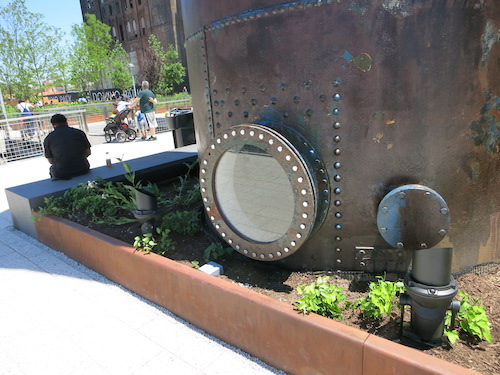
But the interest taken by Real Estate Weekly is also the sharpest indicator of how crucial commercial and financial considerations are to the fate of potential parkland in the city. Its website gushed that Domino Park is "nothing short of miraculous" and "should serve as a national model of urban renewal and an example for future developments."
Kudos, then, to Two Trees Management, owner and operator of the whole Domino redevelopment, including the park. I remember when Two Trees was a small family concern just getting a toehold in Dumbo, where my band shared the rental of a rehearsal studio in the rundown old days. The Domino development will include 2,800 rental apartments. Seven hundred of those will be "affordable." Which means available to (maybe) the five percent, as opposed to just the one percent.
Domino Park isn't just about architecture and real estate. It's also art. Just before it opened, Daniel McDermon of The New York Times heralded "One of this weekend's most anticipated art openings." He was referring to the playground. Designed by Mark Reigelman and incorporating spinning valve wheels cast from Domino originals, it's meant to mimic the sugar refining process. "The idea is that a child enters as raw sugar cane, and exits at the last portion of the playground as molasses, or sugar cubes," Reigelman told the Times. Fun? Creepy? Maybe both. Either way, the ghost of the old Pfizer molasses plant next door would surely approve.
In any case, when I visited, kids were definitely enjoying the refining process.

Meanwhile, up on the Artifact Walk, workers were putting the finishing touches on what looks like a giant "C." What will it help spell? "Come and Play?" "Children Are Our Future"? "Can You Afford to Live Here?"
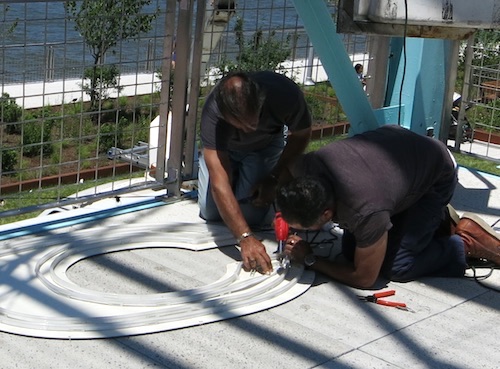
Grown-ups were enjoying the outdoor seating at the Danny Meyer taco shack.
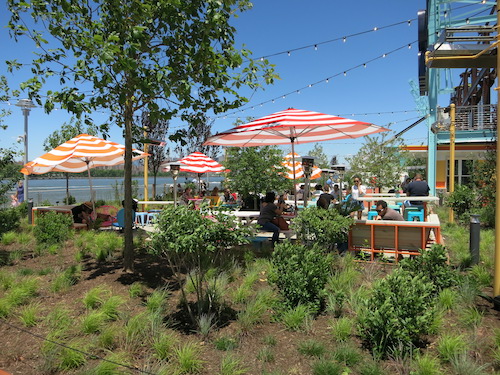
Old screw conveyors, repositioned as design elements, jutted up from the ground.

Below ancient tanks, steam rose from vents installed in a cut-away section of the pier. If this "poof of noirish fog" (as Gothamist slinkily described it) looks refreshing on a hot day, be aware that if you step into the steam, you will get wet.
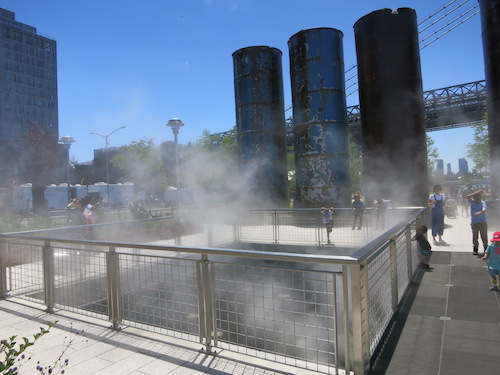
The park is manicured to within an inch of its life. Along with the kinetic fountain, playground, steam vents, and artifacts, there are bocce and volleyball courts and a couple of sharply defined stretches of grass to stretch out on.
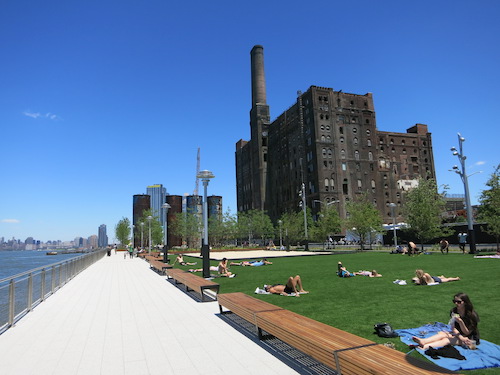
Meanwhile, across Kent Ave., plenty of development remains to be done.
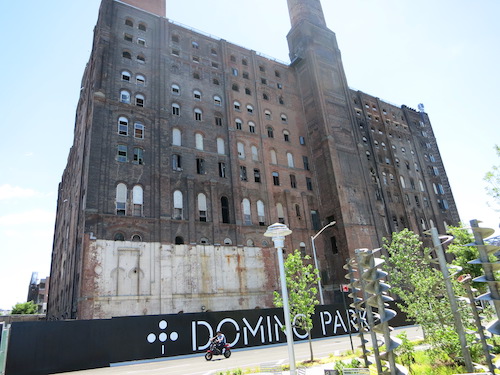
And the life of the city churns on, oblivious, on the nearby streets and on the East River. I spotted the tugboat Coral Coast motoring under the bridge.
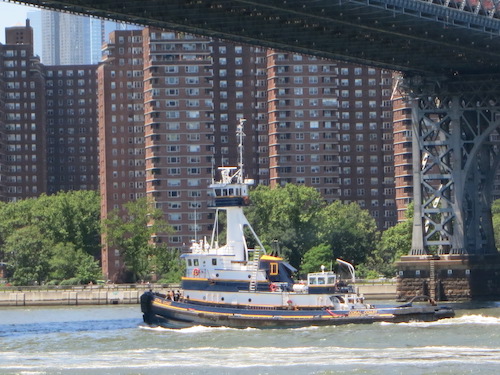
I have mixed feelings about Domino Park, as I do about any public facility run not by the municipal or state government but by private owners. You have to wonder what would happen if – or should I say, what will happen when – the developers fall on hard times. What if the real estate market crashes? Or a huge storm surge or other natural disaster runs roughshod over the sparkling new park, knocking over all the amenities like, well, dominoes?
Of course, when hard times hit, city-run facilities deteriorate too. Just ask the people who founded the Central Park Conservancy.
On balance, any way it comes about, a new park is a good thing. And, all philosophical and social questions aside, on the hot day of my visit this dance step seemed to say it all:

All photos © Jon Sobel, Critical Lens Media
No comments:
Post a Comment